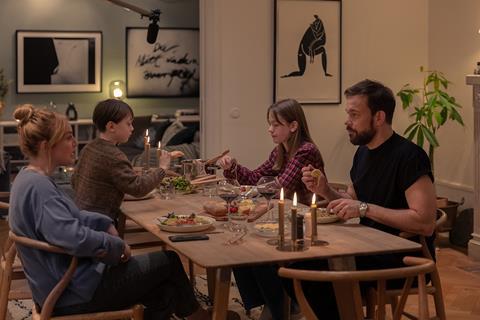 Sponsored content
Sponsored content
Swedish drama has a unique international reputation – beautiful, bleak, slow and spiced with dark Nordic introspection.
A modern Swedish romantic comedy would seem a hard sell, and yet Netflix’s Love and Anarchy has been a hit. The series charts the adventures of Sofie, a married-with-kids consultant who goes into an old Stockholm publishing company only to get involved with twentysomething Max, in the process pulling away from a life of polite respectability into spiralling excitement and danger.
We talked to key members of the production team about how they pulled it off, and how HDR with Dolby Vision are helping to bring Scandinavian television to the next level.
The unique challenges of producing a romantic comedy
“Rom-com has its own aesthetic,” says producer Frida Asp, “and the characters’ arcs have a particular momentum. We’re bringing the viewer into a world that is recognisable and relatable, a naturalistic place, but one that looks like an urban photoshoot for a fashionable lifestyle magazine. We found HDR and Dolby Vision gave us a lot of scope for that – a way to build a world with that style.”
Director of photography Ulf Brantås led that realisation. Like the other members of the team we talked to, this was his first major project using Dolby Vision, but he soon found that new subtleties available to him fit the bill well.

“It was a very positive experience. As we began the work, we found we could create texture and a kind of 3D feel. We found the subtleties made all the difference.”
Colourist Mats Holmgren brought everything together: “It was a step change. At first, I kept it very soft, very SDR, but we found that pushing the colours just a bit gave it a zing without that artificially oversaturated video feel.
It’s much more cinematic.” “It’s very pleasant and it works seamlessly with the overall story, which is so important,” adds Brantås.
Asp says that everyone on the production bought into working with HDR and Dolby Vision, even though it wasn’t in the original budget.
“When we went for it, we had to cover the cost from elsewhere, but it wasn’t that much, so it wasn’t a problem. We didn’t have to cut scenes or anything like that. It was an artistic decision but also a popular one. Every department was involved with the tests, everyone was enthusiastic about the chance to get this experience. Nobody felt short-changed. Quite the opposite.”
HDR and Dolby Vision bring new potential to old techniques
Different aspects of the production took on new importance.
“We found you could see a lot more of the makeup, for example,” says producer Asp. “Every pixel of Sofie’s makeup was visible. So during her arc, we used makeup a lot to show how she developed. You can work with that a lot more with HDR, which is good.”
Asp found that HDR and Dolby Vision let her depict character development convincingly without making them too obvious. “Sofie changes as her experiences get more extreme. She leaves her safe, carefully modulated life and, as things get more exciting and uncertain, she reacts in the way she looks – her makeup, hair, clothes, even how tired she looks. We could portray that with a lot more depth with HDR. That’s really useful in a drama comedy.”
New confidence: how the story is told is how the story is seen
One aspect of HDR and Dolby Vision that gave the team confidence in conveying their vision was consistency of results, during production, through delivery and transmission, and into viewers’ homes. “We have an iPad Pro, Panasonic and Sony monitors in the grading suite, and things looked the same,” says Holmgren.
“Normally, if you have three different devices, you get three different results, especially if you push the gamut, but Dolby Vision HDR looks good in the same way. If you have a [Dolby Vision HDR-capable] TV at home, it’ll look like it did in the suite. The consistency is very important and that’s a new experience for me, to have the confidence that the work is being properly rendered by everyone. 510 nits in the grading suite is 510 nits in people’s homes. As a professional, that’s very satisfying.”
HDR and style
The ability of HDR to work under a wide range of lighting conditions enabled editorial decisions, says Brantås. “We all agreed on a semi-documentary style. That meant it’s not dramatically lit. The actors could go anywhere in a room. There was a lot of freedom for the director and the actors to come up with something that looked interesting.”

Asp agrees that the richness and interest of the shot’s composition and movement carried a lot of weight. “We didn’t want it to be talking heads all the time. There was a lot of dialogue but the audience would discover things through the images too. That worked well,” she says.
In post, the material was graded in HDR and trimmed to SDR. That worked out very well, says Holmgren. “What’s great is that you only focus on HDR where it sits beautifully. When I’m almost done with HDR I check on SDR, zig-zagging between them – 80% HDR, 20% SDR. Basically you get the SDR automatically at the end.”
The drama’s on screen, not in the production
Looking back on the experience of making Love and Anarchy, the team agreed that it was very satisfying to work in HDR and Dolby Vison. It produced a consistent, high-quality experience that told the story with style and panache without calling attention to itself.
“I don’t have a favourite scene,” says producer Asp. “But it was so good to build a world where you can look out of a window and it seems real, where you can see every detail. It has depth, which matches the story so well.”
Brantås sees HDR and Dolby Vision as liberating, not just in terms of production but showing some Swedish sensibilities the world wasn’t expecting.
“Swedish TV drama was about people walking across bridges for hours on end in the rain. Now we have Swedish rom-com, our version of something that’s popular everywhere – half Ingmar Bergman mixed with colourful whimsical, weird, rather childish storytelling. You can’t uninvent that.”





























